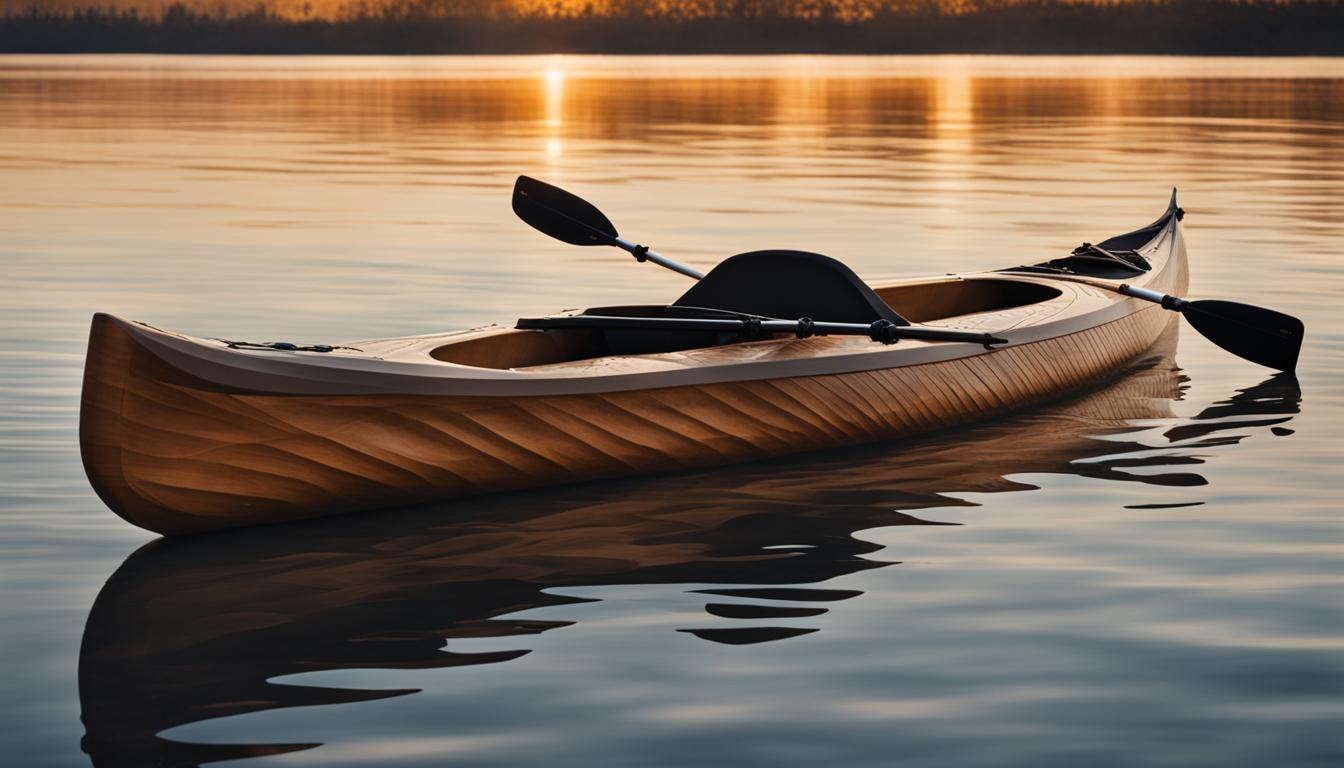Kayaking is a wonderful way to explore the great outdoors while staying mindful of our environment. To further enhance the eco-friendliness of this activity, it’s important to consider sustainable materials for kayak construction. By using green materials and adopting eco-friendly building techniques, you can reduce your environmental impact and enjoy a guilt-free paddling experience.
When it comes to sustainable kayak materials, there are several options to consider. From recycled plastics to reclaimed wood and bio-based composites, these materials not only minimize waste but also promote environmental responsibility in the kayak building industry. Making conscious choices in your kayak construction can have a positive impact on our planet.
Key Takeaways:
- Choosing sustainable kayak materials is a responsible way to reduce your environmental impact.
- Options such as recycled plastics and reclaimed wood help minimize waste in the kayak building process.
- Using eco-friendly materials promotes environmental responsibility in the kayak building industry.
- Sustainable kayak construction can lead to cost savings, improved durability, and a positive brand image.
- By adopting eco-friendly practices, you can contribute to the preservation of our natural resources and enjoy a greener paddling adventure.
Tips for Choosing Sustainable Kayak Materials
When it comes to building a sustainable kayak, the materials you choose play a crucial role in minimizing your environmental footprint. By selecting eco-conscious materials for your kayak construction, you can enjoy a greener paddling experience while promoting environmental responsibility. Here are some tips to help you choose the right sustainable materials for your kayak:
1. Recycled Plastics
Consider using recycled plastics as a sustainable option for your kayak build. These materials are made from post-consumer waste, reducing the demand for new plastic production and minimizing environmental pollution. Recycled plastics can offer comparable strength and durability to traditional kayak materials while significantly reducing your carbon footprint.
2. Reclaimed Wood
If you prefer a more traditional look for your kayak, reclaimed wood can be an excellent choice. By using salvaged or repurposed wood, you give new life to discarded materials and decrease the need for harvesting new timber. Make sure to choose wood from sustainable sources or look for FSC-certified options to ensure responsible forestry practices.
3. Bio-Based Composites
Another sustainable option for kayak construction is bio-based composites. These materials are made from renewable resources such as plant fibers and resins derived from natural sources. Bio-based composites offer strength, durability, and reduced environmental impact compared to conventional synthetic materials. Look for composites that have been certified as environmentally friendly.
By selecting sustainable materials for your kayak, you not only contribute to a healthier planet but also enjoy the peace of mind that comes with responsible outdoor recreation. Remember to consider factors like durability, performance, and environmental impact when making your material choices. With the right materials, you can build a kayak that aligns with your eco-conscious values and ensures a sustainable future for our waters.
A Look at Different Kayak Materials
When it comes to kayak construction, there are various materials to consider. Each material has its own unique advantages and disadvantages, influencing factors such as durability, weight, and performance. Whether you’re looking for a hard-shell kayak or opting for a folding or inflatable kayak, understanding the different materials used can help you make an informed decision that suits your needs.
Kayak Deck Materials
The kayak deck is an important component that affects both the aesthetics and functionality of the kayak. Common materials used for kayak decks include:
- Rotomolded Polyethylene: This material is known for its durability and affordability. It can withstand impacts and is resistant to UV rays. However, it can be heavier compared to other materials.
- Composite: Composites such as fiberglass, carbon fiber, and Kevlar offer lightweight options with excellent strength-to-weight ratios. They provide better performance but can be more expensive.
- Wood: Wooden kayak decks offer a classic and aesthetically pleasing look. They can be custom-built and are often used in traditional kayak designs. However, wood requires regular maintenance to ensure durability.
Kayak Hull Materials
The kayak hull, which comes into direct contact with the water, greatly influences the kayak’s performance and maneuverability. Consider the following materials for kayak hulls:
- Roto-molded Polyethylene: This material is popular due to its durability, impact resistance, and affordability. It is suitable for recreational kayaks.
- Thermoform: Thermoformed hulls offer a lighter and stiffer alternative to roto-molded polyethylene. They provide improved performance and are commonly found in touring and sea kayaks.
- Composite: Composite hulls made of fiberglass, carbon fiber, or Kevlar provide excellent performance, strength, and weight advantages. However, they tend to be more expensive.
Kayak Hatch Gasket Materials
Hatch gaskets play a vital role in keeping water out of the kayak’s storage compartments. The materials commonly used for kayak hatch gaskets include:
- Rubber: Rubber gaskets offer a reliable and waterproof seal. They are durable and can withstand various weather conditions.
- Neoprene: Neoprene gaskets are known for their flexibility and elasticity. They provide a secure seal and are resistant to degradation caused by UV rays.
- Silicone: Silicone gaskets offer excellent resistance to extreme temperatures and provide a reliable waterproof barrier.
Kayak Bulkhead Materials
Bulkheads are partitions within a kayak that create separate compartments and contribute to buoyancy and safety. Some common materials used for kayak bulkheads include:
- Rigid Plastic: Rigid plastic bulkheads provide durability and stability. They can be molded to fit the kayak’s shape and offer effective water-tightness.
- Foam: Foam bulkheads are lightweight and can help with flotation. They are commonly used in lightweight and expedition kayaks.
Kayak Skin Materials for Skin-on-Frame Kayaks
Skin-on-frame kayaks are a traditional kayak design where the frame is covered with a skin material. Traditional materials used for skin-on-frame kayaks include:
- Canvas: Canvas was historically used as the skin material for skin-on-frame kayaks. It provides durability and can be treated for water resistance.
- Modern Synthetic Fabrics: Modern synthetic fabrics such as ballistic nylon or polyester provide lightweight and durable options for skin-on-frame kayaks. They offer improved water resistance and ease of maintenance.
| Kayak Material | Pros | Cons |
|---|---|---|
| Rotomolded Polyethylene | Durable, affordable, impact-resistant | Heavier compared to other materials |
| Composite (fiberglass, carbon fiber, Kevlar) | Lightweight, excellent strength-to-weight ratio | More expensive |
| Wood | Customizable, aesthetically pleasing | Requires regular maintenance |

Benefits of Sustainable Kayak Building
Designing and building sustainable kayaks offers numerous benefits that go beyond reducing environmental impact. Not only can it help protect the environment, but it can also provide cost savings, improved durability, and a positive brand image for boat builders.
Sustainable Kayak Design Ideas
- Use recycled materials: Incorporating recycled plastics and reclaimed wood into kayak construction reduces waste and supports the circular economy.
- Choose bio-based composites: Bio-based composites, made from renewable plant-based materials, offer a sustainable alternative to traditional fiberglass.
- Opt for energy-efficient systems: Implementing energy-efficient systems in kayak manufacturing processes can reduce energy consumption and lower carbon emissions.
- Promote repairability: Designing kayaks with modular components and easily replaceable parts extends their lifespan and reduces the need for complete replacements.
By adopting these sustainable design ideas, kayak builders can create eco-friendly watercraft that align with the principles of environmental responsibility.
“Sustainable kayak building techniques not only benefit the environment but also provide a unique selling point for our brand. Customers appreciate our commitment to minimizing our ecological footprint while delivering high-quality, long-lasting kayaks.”
Reducing Environmental Impact in Kayak Construction
Using eco-friendly materials in kayak construction is a step towards reducing the environmental impact of the industry. Traditional kayak materials, such as rotomolded polyethylene, can contribute to plastic waste and pollution. In contrast, sustainable materials like recycled plastics and bio-based composites have a lower environmental footprint.
Additionally, sustainable kayak building involves implementing efficient production processes that minimize energy consumption and waste generation. By reducing emissions and waste, kayak builders can contribute to a greener and more sustainable future.
Overall, sustainable kayak building techniques not only benefit the environment but also offer tangible advantages such as lower costs, increased durability, and a positive brand image.
| Sustainable Kayak Building | Conventional Kayak Building | |
|---|---|---|
| Environmental Impact | Reduces environmental footprint | Potential for plastic waste and pollution |
| Cost | Potential cost savings in material sourcing | Standard material costs |
| Durability | Can result in more durable watercraft | Dependent on material choice |
| Brand Image | Positions the brand as environmentally responsible | No specific sustainability focus |
Conclusion
Choosing sustainable materials for kayak construction is a responsible way to minimize your environmental impact while enjoying the outdoors. By opting for eco-friendly kayak building techniques and using green materials, you can contribute to reducing the environmental footprint of kayak construction.
Designing a sustainable kayak not only benefits the environment but also offers advantages for you. With cost savings, improved durability, and a positive brand image, sustainable kayak building is a win-win situation.
So, next time you embark on a custom kayak build, consider the sustainable options available. From recycled plastics to reclaimed wood and bio-based composites, there are materials with a low environmental footprint that can meet your needs. By making these conscious choices, you can enjoy a greener paddling adventure while promoting a more sustainable future for kayaking.
FAQ
Is kayaking an eco-friendly activity?
Yes, kayaking is an eco-friendly activity as it doesn’t emit harmful gases.
How can I minimize the environmental impact of kayaking?
You can minimize the environmental impact of kayaking by using gear made from recycled materials, avoiding pollution, being respectful of wildlife, and being mindful of the environment.
What are some sustainable materials for kayak construction?
Sustainable materials for kayak construction include recycled plastics, reclaimed wood, bio-based composites, and polycarbonate.
What are the different materials used in kayak construction?
Different materials used in kayak construction include rotomolded polyethylene, thermoform, composite, wood, folding materials, and inflatable materials.
What are the benefits of sustainable kayak building?
Benefits of sustainable kayak building include reduced environmental impact, cost savings, improved durability, and a positive brand image for boat builders.
How can I choose sustainable materials for kayak construction?
You can choose sustainable materials for kayak construction by considering options with low environmental footprints, such as recycled materials, reclaimed wood, and bio-based composites.
How can I contribute to a more sustainable future while kayaking?
You can contribute to a more sustainable future while kayaking by choosing recycled materials, using energy-efficient systems, and adopting eco-friendly practices.





